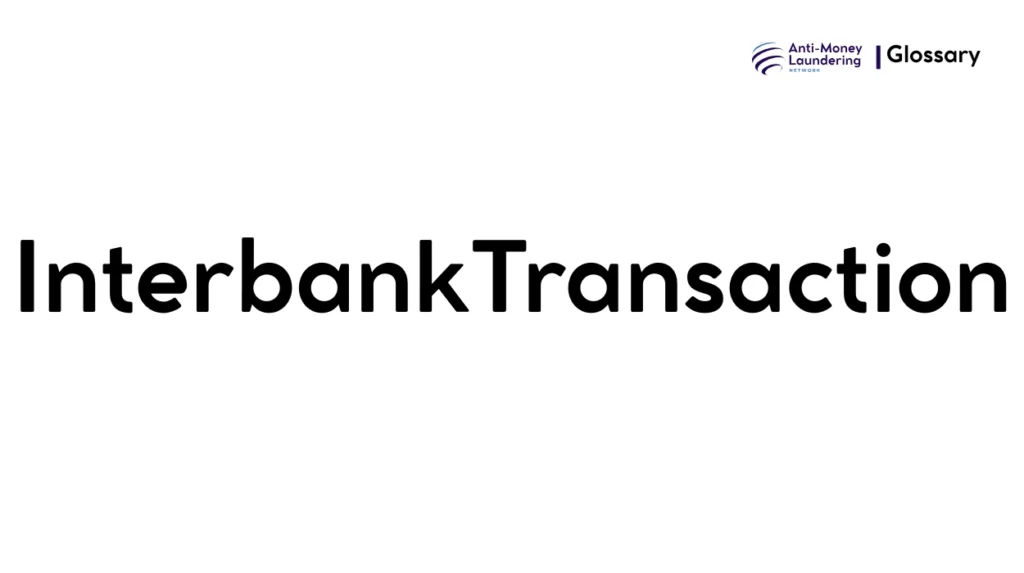Definition
An Interbank Transaction is a fund transfer executed between separate banking entities, often via regulatory-approved messaging systems such as SWIFT. It is a critical AML focal point as it can be exploited to obscure the origins of illegally obtained funds by virtue of moving money across multiple banking institutions.
Purpose and Regulatory Basis
Interbank transactions are pivotal in maintaining the flow of legitimate financial operations but also present vulnerabilities that criminals exploit for laundering money. AML frameworks emphasize monitoring these transactions to ensure transparency and to thwart the use of banks as conduits for criminal funds. Key global and national AML regulations that govern interbank transactions include:
- FATF Recommendations: Stress international cooperation and transparency in cross-border banking transactions.
- USA PATRIOT Act: Imposes stringent customer identification and transaction reporting requirements for interbank fund transfers.
- European Union AML Directives (AMLD): Set out detailed obligations for institutions regarding cross-border transfers to prevent money laundering.
These laws collectively require banks to implement robust controls around interbank transactions to detect suspicious patterns, report large or unusual transfers, and maintain audit trails.
When and How it Applies
Interbank transactions apply whenever funds move between banking entities, such as:
- Transfers of funds from one bank’s client account to another bank’s client account.
- International wire transfers sent or received through networks like SWIFT.
- Settlement transactions between correspondent banks.
These transactions are triggers for AML systems if they involve unusually large amounts, atypical frequencies, or originate from or are sent to high-risk jurisdictions or entities.
Types or Variants
Interbank transactions can be classified based on several criteria:
- Domestic vs. International: Domestic transactions occur within a single country, whereas international ones cross national borders.
- Retail vs. Wholesale: Retail transactions involve end customers; wholesale might include settlements between financial institutions.
- Swift Transfers: Standardized international message-based transfers facilitated by the SWIFT network.
- Correspondent Banking Transactions: Banks acting on behalf of others to facilitate payments especially in foreign currencies.
Each type carries specific AML risk profiles based on volume, speed, and geographic exposure.
Procedures and Implementation
Institutions comply with AML standards concerning interbank transactions by:
- Customer Due Diligence (CDD): Verified identity for sending/receiving parties.
- Transaction Monitoring: Automated systems analyzing transaction size, frequency, and origin/destination.
- Suspicious Activity Reporting (SAR/STR): Filing reports on transactions with indicators of illicit activity.
- Record Keeping: Maintaining detailed logs for regulatory audits.
- Use of Technology: Employing real-time screening tools, sanctions lists checks, and anomaly detection algorithms.
Impact on Customers/Clients
From a customer perspective, interbank AML controls may:
- Result in additional verification or documentation requests.
- Cause delays for high-value or international transfers.
- Restrict transactions with sanctioned entities or high-risk locations.
Customers also have rights to be informed about holds or denials where applicable, balancing transparency with regulatory compliance.
Duration, Review, and Resolution
Interbank transactions are subject to ongoing review:
- Duration: Monitoring occurs at the transaction time and as part of post-transaction analysis.
- Review: Regular audits of transaction records and AML controls.
- Resolution: Suspicious transactions may lead to account freezing, investigations, reporting, and cooperation with law enforcement.
Reporting and Compliance Duties
Banks must adhere to strict reporting requirements:
- Report all large or suspicious interbank transactions to financial intelligence units (FIUs).
- Maintain comprehensive documentation proving due diligence and monitoring.
- Train staff regularly on AML policies.
- Face penalties, fines, or sanctions for non-compliance.
Related AML Terms
Interbank transactions intersect with key AML concepts such as:
- Transaction Monitoring: Continuous analysis of financial transfers.
- Correspondent Banking: Intermediary bank relationships.
- Suspicious Activity Reports: Formal alerts on potentially illicit transactions.
- Customer Due Diligence: Validation of parties involved.
Challenges and Best Practices
Challenges include:
- High volume and complexity of transactions making manual review unfeasible.
- Evolving laundering techniques leveraging cross-border transactions.
- Regulatory variations across jurisdictions.
Best practices involve adopting advanced analytics, maintaining updated sanctions lists, implementing risk-based approaches, and fostering international cooperation.
Recent Developments
Recent trends include:
- Enhanced use of AI and machine learning for transaction pattern recognition.
- Increased focus on real-time transaction monitoring.
- Regulatory emphasis on transparency in correspondent banking.
- Adoption of blockchain analytics for cross-institutional transfers.
Interbank transactions are a core component of the financial system but also a critical AML risk vector. Diligent monitoring, robust controls, and compliance with key regulations are essential to maintain the integrity of financial institutions and combat money laundering effectively.

